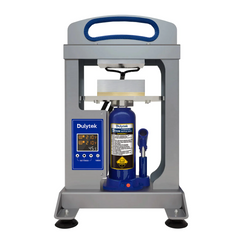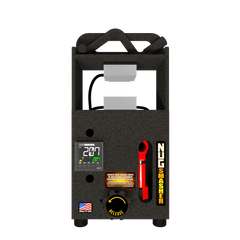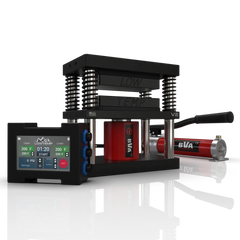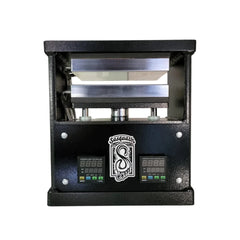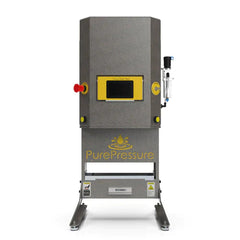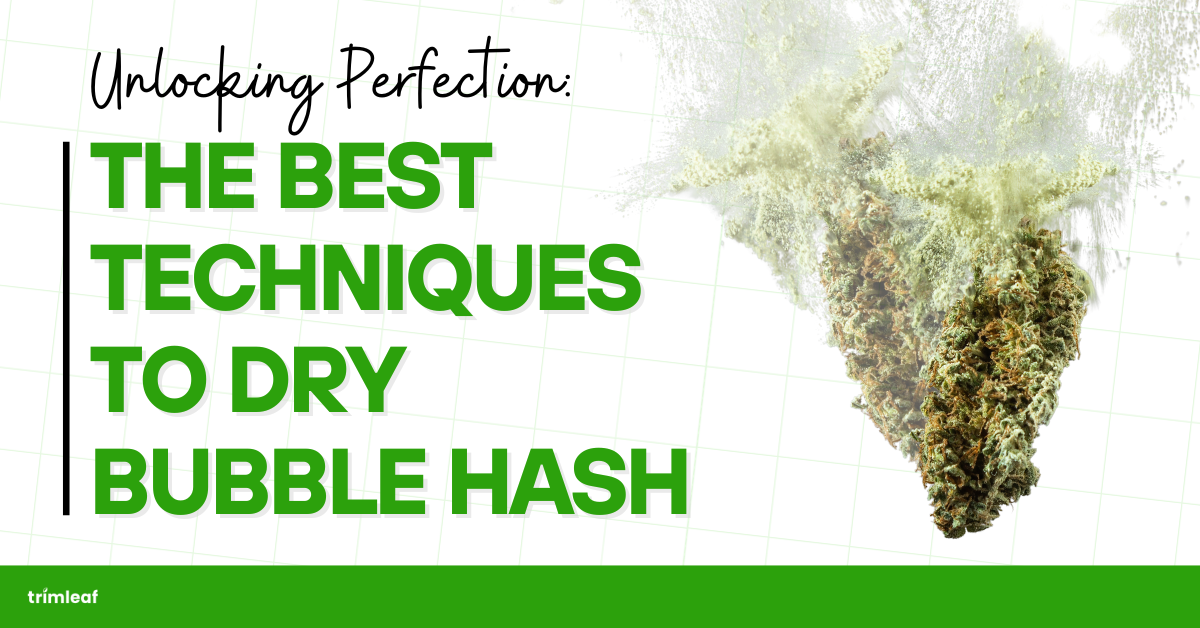
You may have read or heard the hottest new concentrate on the block, rosin, and perhaps wanted to dig deeper into what it actually is & get some questions you have about the topic answered. Well, you've found the ultimate resource on the Internet on everything you need to know about rosin.
In this post, we'll cover what exactly rosin is, how to make rosin, what variables affect the quality of your rosin, and finally, the best instruments & tools to make rosin out of.
Table of Contents
- What is Rosin?
- What is Rosin Used For?
- Key Benefits of Rosin
- The Triumvirate of Yield: Heat, Pressure, & Time
- How Do You Make Rosin?
- What Yields Can You Expect?
- Starting Temps & Pressure Guidelines by Material
- Storing Your Rosin
- How to Press Rosin
- What is a Rosin Press?
- Questions to Ask Yourself Before Buying a Rosin Press
- Types of Rosin Press
- DIY Heat Plate Kits
- Manual Rosin Press
- Hydraulic Rosin Presses
- Variable-Hydraulic Rosin Press
- Pneumatic Rosin Presses
- Electric Rosin Presses
- Troubleshooting Common Issues
- Expert Tips to Level-up Your Rosin Game
- Conclusion
- Frequently Asked Questions About Buying a Rosin Press
What is Rosin?

Rosin is a concentrate obtained by extracting the essential oils of the cannabis plant, which encapsulates its distinctive taste and aroma. This is achieved through a combination of heat and pressure, a method that doesn't involve any foreign substances.
One crucial aspect to note about rosin is its state of activation. Since the process involves heat, rosin is decarboxylated during extraction. This means that the THC in rosin is activated and ready to consume without further heating or cooking.
This feature contributes significantly to its rising popularity, positioning rosin as a strong contender in the extracts market. The final product is not only potent and pure but also retains the authentic taste and smell of the cannabis strain it was derived from.
What is Rosin Used For?
Rosin can be enjoyed in several ways, each offering a unique experience. The most popular methods include:
- Dabbing: This involves using a dab rig, which heats the rosin to a very high temperature, vaporizing it instantly for a powerful and immediate effect.
- Vaping: Rosin can be used in vaporizers designed for concentrates, offering a more controlled and gradual experience.
- As an Edible Ingredient: Already activated, rosin can be directly added to foods or used in edibles for a longer-lasting effect.
- Sprinkled on Flower/Infused Pre-Rolls: Rosin can be sprinkled over cannabis flower to enhance potency and flavor. Additionally, many enthusiasts enjoy using rosin in infused pre-rolls, where the rosin is either mixed with the flower or coated on the exterior, offering a convenient and potent smoking experience.
- Twaxing: This creative method involves rolling rosin around the outside of a joint or blending it with the flower inside.
Each method provides a unique way to enjoy rosin, and the best choice depends on personal preference and the desired effects.
Key Benefits of Rosin
✓ Solventless Purity
Unlike BHO, Rosin stands out due to its solventless extraction process, relying solely on heat and pressure. This eliminates the potential for harmful residual solvents that might linger in other concentrate types. The result is a cleaner, potentially healthier product, making rosin exceptionally appealing for medicinal users seeking purity.
✓ Superior Flavor and Terpene Preservation
By avoiding solvents, rosin safeguards the delicate terpene profile of the original cannabis plant. Terpenes are responsible for the unique aromas and subtle flavor notes in cannabis. This preservation translates to a richer, more complex, and ultimately more enjoyable flavor experience that connoisseurs highly value.
✓ Potency and Variety
Rosin packs a serious punch, with cannabinoid concentrations often rivaling or even surpassing other concentrates. Moreover, the extraction process allows for a remarkable range of textures and consistencies. You can find rosin in forms like budder, shatter, or sauce, appealing to a wide variety of preferences.
✓ Versatility
Rosin's allure isn't limited to traditional dabbing. Its adaptability makes it a star ingredient in edibles, providing a potent infusion. It can also enhance topicals or even fill specialized vape cartridges for discreet use. Rosin can even be sprinkled into prerolls for a flavor and potency boost – and the leftover pressed pucks can find new life in infused creations.
✓ Accessibility for Home Production
Commercial-scale rosin production certainly involves specialized equipment. However, the beauty of rosin lies in its accessibility. Enthusiasts can explore small-scale presses and DIY techniques, opening the door to experimentation and personalized rosin creations.
The Triumvirate of Yield: Heat, Pressure, & Time
Heat (Temperature)
Temperature is key to making good rosin! A good rule of thumb to remember is:
- Lower temperatures (190°F- 220°F) = more flavor/terpenes, less yield, end material is more stable (butter-like/honey consistency)
- Higher temperatures (220°F- 250°F) = less flavor/terpenes, more yield, end material is less stable (sap-like consistency)
Bearing these in mind, if your press is more than capable of delivering the right pressure, we don't recommend you going higher than 250°F.
Pressure
While it's tempting to go out to build or buy a rosin press with the highest capacity, science has shown that higher pressure does not equate to higher yields.
Sometimes higher pressure can produce less desirable results because the increase in pressure actually forces less desirable materials such as lipids and other fine particles into your rosin.
Our friends at Pure Pressure broke the science down to a tee on this on their blog if you want to read more about it.
Time
The time to produce rosin varies depending on the material, a strain that you’re using and if there’s enough pressure
How Do You Make Rosin?
Making rosin is very simple because it only requires minimal equipment and minimal investment. You can produce rosin at home and put together a rig for less than $500 or buy one from a reputable brand for about the same cost.
A typical rosin production setup consists of:
- A rosin press
- Choice of starting Material (this can be cannabis flowers, bubble hash, or kief)
- Rosin filter extraction bags
- Parchment paper (unbleached, if possible)
You can press flowers, bubble hash, kief, or even high-quality trim, but each material will give you different yields.
A brief word of caution: not all strains produce rosin equally.
Some strains are known for producing more rosin, while some strains barely produce any rosin at all.
What Yields Can You Expect?
Pressing flowers will give you the best quality rosin but not necessarily the best yields. Generally, the best strains for pressing rosin are frostier on the inside when you break the bud in the middle are the best ones for making rosin.
When pressing flowers, try to go with the smaller nugs since they have more surface area, the more surface area means more travel for the rosin as it is being pressed.
Pressing kief or hash, on the other hand, will give you great quality and decent yields.
| Product | Yield Percentage |
|---|---|
| Trim | 3% - 8% |
| Shake | 8% - 15% |
| Flower | 15% - 30% |
| Kief/Dry Sift | 30% - 60%+ |
| Bubble Hash/Hash | 30% - 70%+ |
Starting Temps & Pressure Guidelines by Material
The time it takes to produce rosin varies depending on several factors, including the quality of your starting material, the specific strain you're using, and the amount of pressure applied. Use the timetable below as a starting point to determine how long you should be pressing based on your starting material. Remember, these are just guidelines, and experimentation is key to finding the ideal settings for your specific needs and preferences.
| Material | Quantity | Price |
|---|---|---|
| Flower | 190°F-220°F | 15-60 Seconds |
| Good Quality Sift/Bubble | 150°F-190°F | 20-60 Seconds |
| Average To Low-Quality Sift/Bubble | 180°F-220°F | 20-60 Seconds |
Storing Your Rosin

Rosin is a perishable concentrate, and its quality degrades over time due to exposure to light, heat, and oxygen. To protect the potency and flavor of your rosin, proper storage is essential.
- Always store it in airtight glass containers in a cool, dark place.
- Avoid plastic, and opt for silicone only for short-term use.
- Minimize how often you open the container to limit oxygen exposure.
- Divide larger amounts of rosin into smaller containers to reduce the frequency of handling the entire stash.
- Clearly label your rosin with the strain, creation date, and any other relevant information.
How to Press Rosin
STEP 1: Preparation
- Select your material: Start with top-quality cannabis flower or hash. Make sure it's well-cured and free of mold or other contaminants.
- Set up your equipment: Place your rosin press on a stable surface in a well-ventilated area. Plug it in, turn it on, and set the desired temperature based on your material.
- Prepare parchment paper: Cut a piece of high-quality parchment paper large enough to fold over your material.
STEP 2: Press
- Load your material: Place your flower (evenly spread) or hash (sandwiched between parchment) in the center of the folded parchment paper.
- Position and press: Place the parchment onto the press, ensuring it lies flat. Slowly apply pressure.
- Collect: Carefully remove the parchment and use a dab tool to collect the hot rosin.
- Store properly: Place your rosin in a non-stick silicone container or parchment paper and store it in a cool, dark place.
Improtant note: Begin with lower temperatures, shorter press times, and smaller amounts of material.
What is a Rosin Press?

A
rosin press is a machine that uses a pair of heated plates to press with enough pressure any cannabis material, such as buds, keif, or hash, which causes the cannabinoids and terpenes to seep out in an oily form called rosin.
Rosin gained popularity with its solventless yet easy extraction process. With the help of micron filtration bags, you get rosin in a matter of minutes with a rosin press.
Questions to Ask Yourself Before Buying a Rosin Press
Here are a few guiding questions to ask yourself to help you determine which rosin press you should buy:
- Will you be using this for personal or commercial use?
- How much are you willing to invest?
- How much rosin do you expect to produce or consume on a regular basis?
- How much space is available for the press and any accessories?
- Do you need something that is portable?
- How comfortable are you with more complex equipment?
- Do you want fine-tuning capabilities or prefer ease of use?
- Are there certain features that are essential for you like ke large plates, built-in pressure gauges, or digital displays?
- Are you comfortable setting up and using additional accessories (such as an air compressor for pneumatic presses)?
Without further ado, let's dive into the extensive world of rosin presses.
Types of Rosin Press
There are different types of rosin presses in the market; you've got your DIY heat plate kits, hydraulic presses, manual presses, variable-hydraulic presses, pneumatic presses, and finally, electric rosin presses.
DIY Heat Plate Kits
As the name suggests, these heat plate kits are typically used when putting together your own rosin press. Putting together your own rosin press is simple and typically involves buying a 10-ton or 20-ton hydraulic shop press and rigging it with ready-made heat plates, heaters and a controller to control the heat on the plates.

Dulytek 3" x 6" Retrofit Rosin Press Kit
If you are interested in putting together your own rosin press, we wrote a post about it and put together different configurations where you can spend as little as $500 for your very own rosin press.
Manual Rosin Press
What's not to love about a simple, hand-crank, hand-powered rosin press that requires nothing but elbow grease to produce rosin?! Typically, manual rosin presses are operated using a pull-down lever or through a twist-style lever to apply pressure onto the plates as you press.
The Dabpress 6 Ton Rosin Press is an excellent choice for anyone seeking efficient and reliable extraction. With its upgraded design, dual heating plates, and precise temperature control, this press ensures consistent results every time. The food-grade anodized aluminum and stainless steel construction guarantee durability, while the wood insulation protects the hydraulic system from overheating, making it both safe and long-lasting.
Hydraulic Rosin Presses
Hydraulic rosin presses are primarily made up of a hydraulic cylinder in order to produce the pressing force needed to apply enough pressure to make rosin. Having enough pressure especially when working with more material is crucial in order to achieve the highest yields. This is why most of the rosin presses that have the highest pressure outputs are hydraulic.
On one end of the spectrum, hydraulic rosin presses are powered using a hand crank to apply the pressure to the plates. However, on the other end, you have your variable-hydraulic rosin presses that has the ability to power the internal hydraulic cylinder using an external pump. These external pumps are typically operated using an air compressor or electrically controlled, though it is also common to see external hand or foot pumps.
Variable-Hydraulic Rosin Press
Pneumatic Rosin Presses
A pneumatic rosin press is powered by an air compressor. With an air compressor, it's literally as simple as pushing a button and you can even increase pressure in small but precise increments (if the press is equipped to do this.).
A lot of commercial-scale producers love using pneumatic presses because of the accuracy, consistency, and rigidity of these units. They do, however, require an external air compressor to run, which may not be the quietest unit to operate.
Electric Rosin Presses
Electric rosin presses, while relatively new to the market, are rapidly gaining popularity. The absence of Rosinbomb, a pioneer in the space, leaves room for innovation. While manufacturing costs, potential pressure limitations, and smaller plate sizes remain considerations, exciting developments like the NugSmasher IQ 4 Ton press are continuing the evolution of this technology.

Electric presses offer advantages like ease of use, portability, and quiet operation. As the market evolves, buyers should consider their pressure needs, plate size requirements, and desired features. Exploring
hybrid options can be beneficial for those seeking maximum power. It's important to note that popular electric rosin press models can experience stock shortages, so research availability before making a decision.
Troubleshooting Common Issues
| Issue | Solutions |
|---|---|
| Low Yields |
|
| Dark, Unpleasant Rosin |
|
| Blowouts |
|
Expert Tips to Level-up Your Rosin Game
- Fresh, high-quality flower or hash will always yield the best rosin. Strive for the perfect starting moisture content.
- Rosin too old or too dry? Use Boveda 62% or equivalent humidity pack to rehydrate dry material slightly for better yields. Experiment within the 58%-62% range to find your ideal.
- Learn the "bottle tech" packing style for maximizing yields and consider directional folds to reduce the risk of blowouts.
- For large batches, a second, lower-temperature press on the same material can extract additional usable rosin.
- Try starting at a slightly lower temperature and ramping up gradually during the press for a more nuanced terpene profile.
- Keep detailed notes on every press session – material type, bag size, temperatures, pressure, time, and yield. Analyzing this data will reveal patterns and help you optimize results.
- Lightly misting plant material with water before pressing theoretically increases steam formation, leading to higher yields.
Conclusion
Rosin's popularity is skyrocketing as a high-quality, solvent-less cannabis concentrate. Offering a potent dose of cannabinoids and pure, terpene-rich flavor, it delivers powerful effects when inhaled through a vaporizer or dab rig. Now, thanks to advancements in rosin presses, making rosin at home or on a commercial scale is both easy and efficient.
Still unsure which rosin press is right for you? Don't worry! Our team of experts is here to help.
Contact us today via email, chat, or by phone at 360-800-5535 to find the perfect rosin press for your needs. Remember, safety is paramount when working with heat and pressure. Be sure to follow recommended guidelines and never hesitate to ask for help if needed.
Learn more about rosin presses:
- Best Rosin Press
- Rosin Pressing Techniques: How to Make Rosin Like a Pro
- Rosin: The Solventless Cannabis Concentrate Taking the Industry by Storm
- 10 Best Strains to Press for Rosin
Frequently Asked Questions About Buying a Rosin Press
- ◄What is rosin, and how is it different from other cannabis concentrates?
- Rosin is a solventless cannabis concentrate created using heat and pressure to extract essential oils, preserving the plant's terpenes and cannabinoids. It's clean, potent, and flavorful compared to solvent-based extracts.
- ◄How can I consume rosin?
- Rosin is versatile and can be consumed by dabbing, vaping, adding to edibles, sprinkling on flower, or twaxing (coating a joint). Each method offers unique effects and experiences.
- ◄What are the benefits of using rosin over other cannabis concentrates?
- The main benefits include purity (solvent-free), superior flavor (preserved terpenes), high potency, versatility for different uses, and accessibility for home production with minimal equipment.
- ◄What are the key factors to consider when pressing rosin?
- The three critical factors are:
- Heat: Lower temperatures preserve flavor but yield less, while higher temperatures increase yield but reduce flavor.
- Pressure: Too much pressure can force unwanted plant material into the extract.
- Time: The ideal pressing time varies by material and affects the quality of the final product.
- ◄What equipment do I need to make rosin?
- Key equipment includes a rosin press, high-quality starting material (flower, kief, or hash), rosin filter bags, and parchment paper. You can either buy a press or assemble one using DIY heat plate kits.
- ◄What yields can I expect when pressing rosin?
- Yield varies by starting material:
- Trim: 3%-8%
- Shake: 8%-15%
- Flower: 15%-30%
- Kief/Dry Sift: 30%-60%+
- Bubble Hash: 30%-70%+
- ◄What temperature and time should I use when pressing rosin?
- For flower, use 190°F-220°F for 15-60 seconds. For good-quality sift or bubble hash, use 150°F-190°F for 20-60 seconds. Adjust these guidelines based on the material and desired outcome.
- ◄How should I store rosin to maintain its quality?
- Store rosin in airtight glass containers in a cool, dark place like a refrigerator. Avoid plastic containers, and minimize exposure to air to maintain potency and flavor over time.
- ◄What are common issues with pressing rosin, and how can I avoid them?
- Common issues include:
- Low Yields: Use fresh material, appropriate temperatures, and avoid overloading your press.
- Dark Rosin: Lower the temperature and press for less time. Use fresher material.
- Blowouts: Apply pressure gradually and use pre-pressed material in filter bags.
- ◄How can I consistently achieve high-quality rosin?
- Experiment with different temperatures, materials, and pressing techniques. Use fresh material with proper moisture levels, and keep detailed notes to refine your process for consistent and high-quality results.


